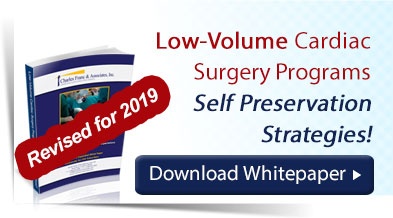Over the last few years, we have continued to blog to keep readers up to date on the evolving state of cardiac valve surgery and the development of transcatheter aortic valve replacement (TAVR) specifically.
As both clinical research results and regulatory changes push TAVR for all into the forefront, hospitals on the cusp of entering this market will need to reevaluate their positions before deciding to move forward.
On March 16, 2019, the NEJM published online the results of two TAVR versus surgical AVR (SAVR) trials in low-risk patients, which effectively ended the debate. At the ACC meeting in March 2019, one of the principal investigators stated that “TAVR is no longer just an alternative therapy, it is the preferred therapy.” [i]
On the heels of these and other similar results, everyone is waiting for CMS to issue its final, updated national coverage determination (NCD), proposed on March 26, 2019. The pending updated TAVR NCD is predicted to reset minimum volume requirements and effectively lower the threshold for entering into and maintaining a TAVR program (see the proposed CMS decision memo). These changes alone, will induce many more hospitals to enter this market. CFA has a number of clients on the verge of making their decision to move forward. Should the volume threshold be lowered by CMS, as proposed, we offer the following summary of critical considerations for implementing TAVR as Part One of a two-part blog post
- Organizational commitment – Expanding the hospital’s structural heart program capabilities to include TAVR will require a commitment on the part of both the organization and its medical staff. This is a significant undertaking in terms of infrastructure, organization and management, physician leadership, staffing and training, and ultimately, financial investment and hopefully, a return-on-investment. While this new service should expand its cardiovascular capabilities, enhance the hospital’s reputation and potentially increase market share (for both TAVR and SAVR), these are never givens, but have to be earned in a competitive marketplace.
- Know your numbers – It is vital that any hospital contemplating TAVR know its current volumes of both SAVR patients and those referred elsewhere for potential TAVR procedures in order to achieve the required minimum volumes. (Refer to CMS New TAVR Coverage Decision Memo: A Gift to Low-Volume Cardiac Surgery Programs? posted 3/29/19 for volume requirements). Going forward must include a breakdown of current SAVR, as well as potential TAVR, factoring in patients deemed “inoperable” due to adverse risk and/or physiological considerations.
- Infrastructure requirements – While the hybrid OR procedure room is the “optimal” site for TAVR, many hospitals will enter the market by using existing cath labs with upgraded levels of imaging equipment. This approach obviates the multi-million-dollar investment required to plan, develop and build out a hybrid OR.
- Staffing assessment will need to be made to match expected volume with existing staffing patterns to ascertain both need and TAVR training requirements. At program initiation, some hospitals will tend to “overstaff’ the procedure, which can be refined over time.
- Valves, delivery systems and related inventory will need to be purchased. Vendors typically require hospitals to purchase the valves up front, adding overhead costs.
- Mandatory participation in the Society of Thoracic Surgeons (STS) and American College of Cardiology (ACC) Transcatheter Valve Therapy (TVT) Registry is required by CMS and has both a participation/licensing fee and ongoing staffing cost.
- Multidisciplinary approach – Ultimately, any structural heart program should optimize its efficiency and effectiveness through multidisciplinary decision-making processes involving both cardiology and cardiac surgery. Input from all disciplines in evaluating candidates for therapies and interventions can be institutionalized into a cardiac valve clinic situation, or less formally through close communication between referring cardiologist, cardiac surgeon and other team members. Realistically, referring cardiologists will tend to “pre-select” TAVR candidates and send them on to the preferred interventionalist. In larger volume programs with formalized cardiac valve clinics and programs, dedicated nurse practitioners are often charged with coordinating the multidisciplinary meetings, clinics and processes necessary to achieve the desired clinical outcome. Newer, smaller volume programs will be challenged to have existing staff multitasking with various targeted groups to achieve the same ends.
- Trained operator(s) – While both interventional cardiology and cardiac surgeons can be trained to performed percutaneous valve procedures, it is the cardiologist that controls the patient and ultimately controls the procedure. The primary operator will need to be trained in the new procedure and achieve a certain level of proficiency and experience before initiating a new program. Specific roles, and any turf issues will need to be addressed before the program can proceed. Obviously, the skill of the individual operator will be critical to building a high-quality program over time.
- Clinical philosophy and approach – Whenever clinicians initiate a new procedure, they tend to take a conservative approach in both patient selection and clinical protocols. As patient selection criteria, risk assessment and clinical application is further refined through clinical trial results, a focus on the treatment protocols seems logical. Initially, when these procedures were new (and riskier), the use of general anesthesia or transesophageal echocardiography was used. As experience progressed, many hospitals began using a so-called “minimalist” approach with protocols that call for conscious sedation and local anesthesia, eliminating sternotomy, cardiopulmonary bypass, and tracheal intubation. Thus, conscious sedation dramatically reduces procedure time, time in the ICU post-procedure, and patients’ hospital stay, resulting in lower costs, better health outcomes, and greater patient satisfaction. Ultimately (and at the appropriate time) focusing on reducing overall procedure cost is a critical factor, as these are expensive procedures where reimbursement levels may not cover costs, particularly at low volume levels.
It is important to recognize that while AVR represents about 75% of all cardiac valve surgeries, transcatheter mitral valve procedures are now in active clinical trials and, if ultimately proven successful, will have similar impact (and generate the same issues) as those found with TAVR; further increasing the importance of transcatheter technologies on cardiac programs in general, and the overall importance of this market segment.
Some lower-volume cardiac surgery programs can be expected to benefit from the decreases in required volumes for combined SAVR, overall catheterization procedures, PCIs and going-forward TAVRs under the proposed NCD. If adapted, these changes will significantly impact entry into this new market.
Structural heart services[ii] including TAVR (and also transcatheter mitral valve repair and replacement) are complex and demanding services. Beyond the question of “can we meet the current and/or proposed standards,” comes the larger, more complex question of “should we enter this market?” With the latter question, each hospital will have to assess its own corporate strategy, internal existing/potential volumes, referral patterns and practices, payer mix/procedural cost/reimbursement, capital investment, operational capabilities, competition within the marketplace, physician leadership and capabilities, and other pertinent questions similar to those raised above.
In Part Two of this blog post, we will address in more detail many of the issues raised above, including program planning, development and implementation needs; assessing prospective financial performance, physician and staff training, infrastructure needs and other related topics.
If you are interested in learning more about low-volume cardiac surgery programs strategies, please download our updated and expanded white paper (please see Low-Volume Cardiac Surgery Programs: Grow, Consolidate or Divest: Self-Preservation Strategies and Excellence Expectations). If you are interested in cardiac services strategic development, service expansion and/or other programmatic needs for cardiovascular or other services, please contact CFA at (949) 443-4005 or by e-mail at cfa@charlesfrancassociates.com.

Footnotes
[i] Allar, Daniel, Cardiovascular Business, May/June 2019, page 32, quoting Michael J. Reardon, MD, Houston Methodist Hospital, ACC19.
[ii] See also Valve Surgery Trends and Implications, posted June 28, 2018, and Mitral Valve Surgery Trends and Implications, posted March 14, 2019.

